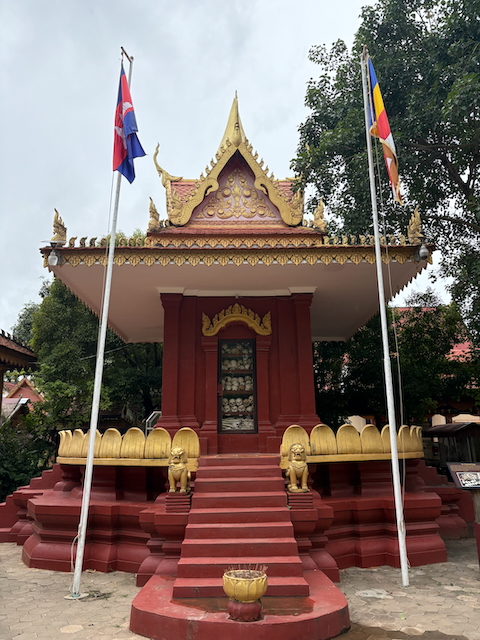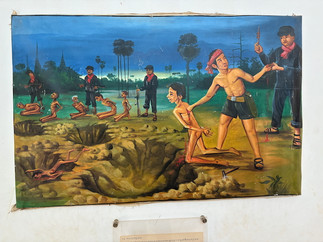The Dark Days of Cambodian History
- Ian Rosenberg

- May 30
- 8 min read
If there’s one other thing that Cambodia is known for worldwide besides Angkor Wat, it’s not its food (which is delicious) nor its hip cities or beautiful nature, but the years of the Khmer Rouge. The Khmer Rouge only ruled for just under 4 years, but in that period, wreaked utter havoc upon the country, sending it back decades compared to its neighbors Thailand and Vietnam. During this time, tens of thousands of land mines were planted all around Cambodia, primarily in the northwest.
But the more important thing to remember is that the land mines stay as long as they go unexploded. Only a few self-deactivating land mines were tested and deployed, and even those failed. Which means that to this day, the thousands of mines still sitting in fields around the country injure and kill many. Around Siem Reap, most of the mine fields have been cleared by now, but in much of the rest of the country, you really have to be careful of where you step. Walking around Siem Reap, you notice a significant number of missing limbs on people. Around Angkor Wat and on Little Pub Street, bands of land mine survivors play traditional instruments begging for any money that can help them with their treatment. After being maimed by a landmine, most of these people cannot return to their lives as normal.
See, land mines are not intended to kill. They only contain enough explosive, they’re designed to blast in a certain way such that it will take a limb off or an eye out, but not kill you. To the enemy, a wounded soldier is something you need to take care of—an expenditure of resources. If they just killed, all that soldier would need is a burial. But needing to heal, get prosthetics, and undergo therapy for a missing limb is significantly more burdensome on an enemy, and therefore, was the tactic that the factions in the Cambodian Civil War opted for.
We experienced three things related to the Cambodian Civil War and Genocide. But first, I think I should mention exactly what happened. Cambodia is a very ethnically homogenous country. There are some Muslim groups in the north, and Vietnamese in the south, but primarily, about 90% of Cambodia is, and was before the genocide, Khmer. The Cambodian Genocide, therefore, needed another target.
Pol Pot was a true Cambodian, educated in France. While in France in the mid 20th century, he learned about socialism and communism. He became a fervent believer that for Cambodia to be successful, it needed to return to an agrarian system built on collective life. After returning to Cambodia, he gained power on this platform, and became dictator of Cambodia in 1975 following victory in the Cambodian Civil War. Under his beliefs, he relocated people out from the cities into the countryside. Children no longer slept with their families, but rather, in collective houses. Meals were served out of one massive pot, and everyone got the same amount of the same food in each community. Days were spent exclusively working in the field, education was not permitted. With Pol Pot’s rise to power, he reset the Cambodian calendar back to year 0, symbolically cutting Cambodia off from the knowledge that the rest of the world has created.
So who was the enemy? It was the educated. Anyone accused of being educated, meaning even doctors, were shot. Anyone who wore glasses was shot, accused of intellectualism. Cambodia nowadays is way behind its neighbors Vietnam and Thailand, and I claim you can chalk this down mostly to the fact that the country had a hard reset only 50 years ago.
Shockingly, Pol Pot fled after being successfully brought down, and lived out the remainder of his life in northern Thailand, dying of natural causes.
We visited a killing field site in Siem Reap, which was incredibly depressing. Walking around, this site is now a temple, with golden shrines much like those of Thailand, but instead of one large shrine, they’re several small shrines. But you’d come across a well where they’d throw bodies into after shooting them. Or they had a mass grave excavated on display. But most chilling was the bone shrine. In the main structure of this shrine was piles and piles of bone on display, contrasting sharply with the dark reds and bright golds in the rest of the shrine. It was placed so nonchalantly—there was little attention paid to it, just a sign stating that the bones are of those who were killed there. It shows the numbness to death that Cambodia went through in that time.
Nowadays, the area acts as a monastery, where little kids dressed in bright orange robes dedicate their lives to the teachings of the Buddha. I tried to put myself in their shoes, but I simply couldn’t. For them, all they know is that their home is by this temple of bones. That’s normal to them. They don’t think about it every time they pass by. It’s just something that’s there, meanwhile, for us, it was the reason we came.
Also in the Killing Fields was an art exhibit with paintings depicting the life of one of those who the Khmer Rouge tried to kill, though unsuccessfully. These pieces of art were so raw. They were not ornate, not beautifully done. They brought exact and purposeful attention to this boy’s story. And the things they showed were just awful. The methods of torture, the mass graves, the feeling of knowing that you are walking to your death. Something that cannot really be captured, because nobody who hasn’t been through that can truly understand how evil the Khmer Rouge was.
* * *
We also visited two sites related to the active efforts going on to clear land mines from rural areas, with the hopes that every landmine is found before a child can. The first was the Cambodian Landmine Museum, built on land where 11 mines were cleared. The museum is the passion project of the first person in Cambodia to take on the mission of clearing landmines. Aki Ra was never injured by a landmine, and his drive for removing landmines from the ground is not simply because he doesn’t want what happened to him to happen to someone else. Instead, his drive is that he wants to propel Cambodia into the future. He sees landmines as an obstacle for that. As long as a large amount of the population will have their life ruined in an instant, resources that should be used to improving the quality of life of the people are instead being diverted to helping those injured.
In his childhood, Aki Ra was orphaned by the Khmer Rouge, as both his parents were taken away on count of being intellectuals. He joined the Khmer Rouge, not by choice, where he was taught to read and more importantly, how to use a gun. Aki Ra was forced to join the Khmer Rouge. Once his village was liberated from the Khmer Rouge by the rebels, he was enlisted to fight for them. Finally, he fought for the Viet Cong during the Vietnam War as well, as that did spill over into Cambodia. He never had a home, never had a family, and never had an allegiance. He stood for what was right and believed in what was right, but he was always taken advantage of by those organizations. He only aligned himself with places that could give him shelter, food, and safety, throwing his morality out the window. In one story, he said that he nearly shot his uncle in battle, realizing only a split second before pulling the trigger who it was he was going to shoot. They were forced on opposite sides of the battle—they were not fighting because they believed in opposite causes, rather, because it’s where the forces of the factions pulled them. He now lives at the landmine museum with that same uncle, and it’s a story they now can laugh about today.
Aki Ra has a bit of a troubled record in the landmine clearing business. The UN agency responsible for clearing landmines has placed skepticism on Aki Ra’s methods, citing non-compliance with the protocols of landmine removal. Despite this, Aki Ra has now taken classes on deactivating landmines, and has several teams of NGOs from around the world supporting his work. Together, they’ve removed tens of thousands of landmines from rural Cambodian areas.
The museum also had an impressive collection of decommissioned landmines on display (and part of the reason Aki Ra was under scrutiny is that previously, some display mines were found to not be deactivated correctly). There are three main kinds of mines used in Cambodia.
The antipersonnel mine is a metal disc buried underground which activates with approximately 5 kg of weight. It blows up on the spot, detonating the gunpowder inside. The tripwire mine is set with a stake in the ground and a tripwire connecting across to some shrubs. The tripwire mount is barely visible off the ground when set correctly. When set off, a fuse lights, sending a gunpowder cylinder into the air. It is timed to detonate half a second after takeoff for maximal injury to the body. The third kind is an antitank mine, which is significantly larger, has much more gunpowder, but won’t go off unless a large amount of weight is put on it. Though these don’t go off often, when they do, they will kill whoever is unlucky enough to set it off.
Originally, the landmines were just antitank mines, which, in comparison to the rest, are decently humane. They really don’t cause major problems in Cambodia anymore due to their high weight threshold. But the problem with them was that people could easily decommission an antitank mine when found, for this same reason. So that’s why the antipersonnel mine was created—to deter people from decommissioning the more valuable mines. As time went on, the antipersonnel mines became more and more common, to the point where they now plague society five decades after the conflict.
The museum had several mock minefields set up, where you may be on a swing set or sitting at a bench, or maybe just walking through some plants, before you realize that you’ve accidentally blown your leg off. It’s amazing just how discrete these mines are, and it’s no shock that they are just as effective as they’re designed to be. It’s truly scary.
So, to avoid humans setting off these land mines accidentally in the process of finding and decommissioning, we’ve turned to animals. Giant African Rats are a species of rat trained by Belgian company APOPO specifically to find gunpowder. They can detect even micrograms of gunpowder across a field, stopping exactly above the spot they detect. They are light enough to be able to stop over a mine exactly without detonating it, and when trained, they cooperate better than most pet dogs. It does help that for them, finding a landmine means that they get a pretty big treat…

To clear minefields, APOPO volunteers stand across from each other with a rope between them. The rat is clipped to the rope and knows to run to the other side, sniffing for gunpowder on his journey. They move systematically through the minefield, one zig or zag at a time, until it’s all cleared. The rats function best when it’s not as hot out, and they can only work three hours per day. Thus, a rat’s workday is 6 to 9 AM, and then they get to relax in a five-star rat hotel until the next day. It’s honestly amazing just how successful it is…in the minefields cleared by APOPO, there is not a single instance in which a mine has been missed.
Something else the rats can do that humans can’t with just a metal detector is know when a suspect mine is truly a mine, or just a piece of scrap metal from a previously exploded mine. Because the rat sniffs for gunpowder exclusively, it will pass over any scrap metal. This saves genuinely days while clearing a minefield. Now, they only spend time digging out genuinely dangerous material, not red herrings.
Both of these efforts have done wonders in reducing the casualty numbers in Cambodia, but it really isn’t even close to being over. The story of Cambodia’s landmines is one that will continue long into the future, but the more progress that’s made, the more Cambodia can move on from its past and embrace change.

























I would never hold one of those rats! It proud of you for holding those “heroes”